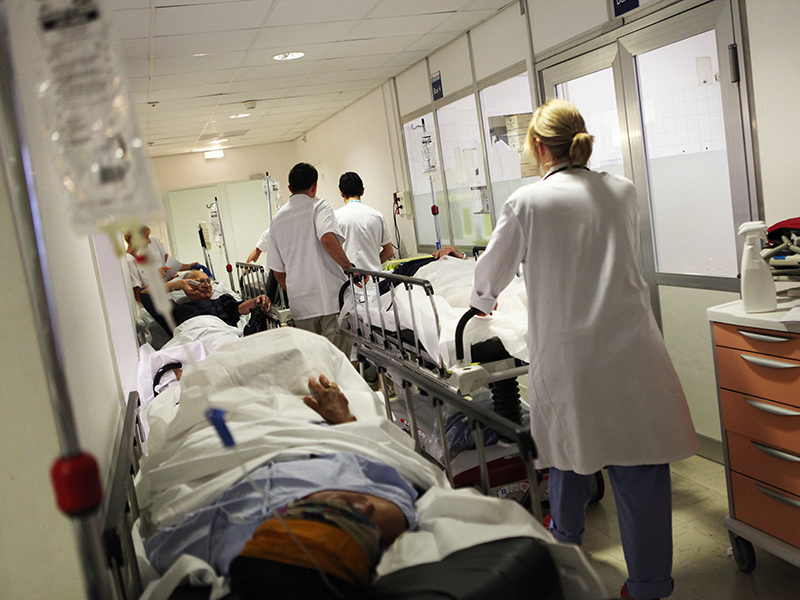—Surprised? Don’t be
By Jeffrey E. Keller, MD
How safe is correctional medicine?
People naturally assume that working in a jail or prison is dangerous. “Aren’t you nervous about working there?” they ask me. What people have seen of jails on TV looks pretty rough! After all, that’s where they put the violent criminals, right? The problem is, it just isn’t so!
Jails and prisons are not dangerous places to work; to assume so is just one of many misconceptions people have about correctional facilities. In fact, my jail medical clinics have been a much safer work environment than where I worked before.
I started out as an emergency physician and worked in a busy ER for upwards of 25 years. During that time, I was slapped, punched and kicked — several times — and had to wrestle with many out-of-control patients.
I was spat upon.
A patient peed on my leg.
I was pooped on — don’t ask.
One patient pulled a knife on a colleague in a small exam room.
A good number of guns were found by me and my colleagues while cutting clothes off trauma victims. And guns were found hidden in the waiting room!
Though I myself witnessed no shootings during my ER years (thank goodness), gunfire in emergency departments across the country has not been uncommon, and staff members have been among the victims of these shootings.
But interestingly, no one ever said to me during my ER days “Wow! Aren’t you nervous about working in that dangerous ER?” That is because most people have been in an ER and so know from experience that overall these are not really dangerous places. On the other hand, most people have not been in a correctional facility. All they know about jails and prisons is gleaned from movies and books. And in movie-land, danger sells.
So how dangerous are my jail medical clinics? Well, during the 15 years that I have been working in correctional medicine, nothing has happened like my ER experiences. Not once! The worst that has ever happened to me in my jail clinics is that my patients have occasionally yelled at me.
Some have even called me a &#%@! Is that all you got? (Yawn!)
There are several reasons why my jail medical clinics are safer overall than a typical ER:
1. Weapons are forbidden in correctional facilities. The jail deputies do not carry guns while on duty in the jail. This is not because they don’t carry firearms. Just like patrol officers, detention deputies are issued a service weapon — and they are expected to carry it when not in the jail, even when not on duty. But when detention deputies come to work at the jail, they secure their weapons in lockers at the jail entrance. No guns are allowed in the facility — at all! Most jails and prisons require all employees and visitors to go through an airport-like metal detector to make sure that no weapons end up in the jail.
2. Inmates in jail and prison are, for the most part, sober when I see them. It is hard to stress how important this is! The worst patients in the ER were those who were drunk, belligerent and wanting to fight. Inmates in the jail medical clinic have sobered up and so are that much less belligerent.
3. Even if a jail inmate wants to fight, I don’t have to be involved. Burly detention deputies are always nearby. Though we try to safeguard patient privacy as much as possible, in a jail, safety and security take precedence over privacy. This means that security staff are always close, so they can respond immediately if need be.
During most clinical encounters in my jails, the detention deputy is situated just outside the room to allow some privacy, but still be able to respond immediately if something happens. if an inmate has a high enough security level, one deputy (or even two) may literally stand right next to me.
4. Inmates are punished for acting out in clinic. This rarely happens in an ER. But in a jail, the punishment is no joke. Ill-behaving inmates can lose privileges (like not being able to buy from the jail commissary or the loss of visitation rights), be transferred to maximum security status or even face additional criminal charges. Nothing dissuades bad behavior more than swift and sure consequences!
5. Lastly, I can terminate a clinic appointment, knowing that I can see the inmate patient again in a day, or even in a couple of hours. He is just in his cell down the hall. This is my “go to” response to someone swearing at me: “We’re done now, but I’ll see you again in a little while after you have calmed down.” In the ER, I had to put up with bad language, because if I kicked a patient out of the ER, I might never see them again. That was likely my one and only chance to make the diagnosis.
Of course, I am not saying that inmate-on-staff violence never occurs in jails, because it does. By far and away, however, most of this involves the security officers, not the medical staff. Thank goodness for them!

